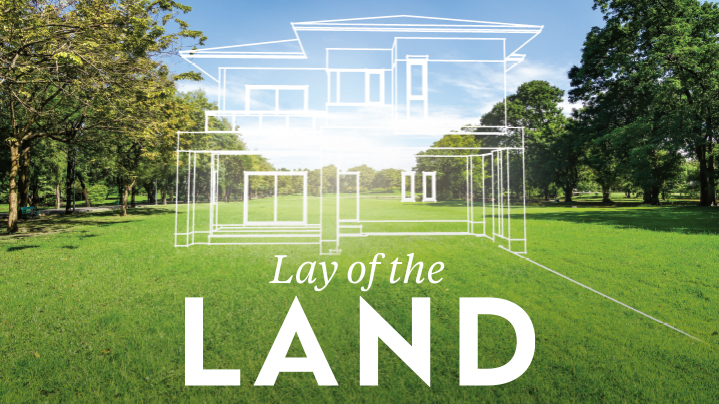Lay of the land
With a focus on intensification pushing the value of developable land upward, Bayleys investigates why some homeowners are looking to build new, and what the process looks like under current market conditions.
Encouraged by a Government mandate to provide more homes at scale and pace, Kiwis are increasingly attracted to sections and lifestyle land while dreaming of building new.
However, challenges persist in a rapidly moving marketplace.
While the system for buying land and building new may have stayed the same for the last several decades, evolving technology and the availability of technical information can help to guide the decision-making process.
Similarly, future projections for rising property prices and a squeeze on building labour and materials have seen a shift in the way we look for viable land. Bayleys investigates what the process looks like for budding builders under new market conditions.
LIFESTYLE ASSESSMENT
Finding the right plot of land to achieve your building goals could well be the most important part of the planning process.
Whether you’re creating a dream home for your family, or purchasing land for investment, rental income or to on-sell once complete, considerations around features and accessibility are top of the list.
Bayleys experts advise would-be landowners to ponder the distance from local amenities (hospital, school, supermarket) that your family, tenants or future purchaser would value most.
Informed by the experience of extended lockdown restrictions and the global pandemic, Kiwis are finding a new appreciation for the great outdoors, so access to cycleways, local hiking trails, beaches and playgrounds are also a key consideration.
It’s also a good idea to check in with your local council regarding new and planned infrastructure projects which could have an impact on your community and the future value of local properties.
Once you have identified one or several target neighbourhoods, a macro assessment of suitable sites is required.
Look for workable land within your budget, considering the size and cost per square metre rate as well as contour, aspect (current and potential from multi-level development) and access during the build process for construction vehicles.
Buyers will also want to look at surrounding properties to ensure they have minimal impact on the site’s ability to secure sunshine, a pleasant outlook and privacy.
SITE CHECK
Once you have found the right site that ticks all your boxes, analyse more technical information before pulling the trigger on a purchase. This includes;
• Obtaining local council plans and understanding the site’s zoning allowances. Different zones allow for a variety of development so before embarking on the build process, have a look over available plans for the immediate and surrounding areas to ensure your site is fit for purpose.
• Search for utility connections. When building on a site, connections such as electricity, water, sewerage, stormwater and internet are imperative considerations. Limited access to these connections could result in uneconomic development costs or limitations on what you can and can’t do with the site.
• Get to know the site. Experts say you only know a home once you’ve lived in it through the seasons. If time allows, visiting your site in various weather conditions and at different times of the day could offer valuable insight on aspects with the potential to impact your building plans.
FUNDING
With New Zealand’s recent Consumer Price Index (CPI) release rising to its highest level in more than a decade, the annual inflation figure has hit 4.9 percent at the end of the September quarter, putting pressure on policy-makers to tighten monetary policy.
Where the Reserve Bank (RBNZ) is expected to raise the Official Cash Rate (OCR) in upcoming reviews, reaching two percent by 2023, the winds of change are blowing through our financial system with an impact on borrowers.
Where mortgage rates look likely to continue on an upward trajectory, alongside the cost of goods and services, Bayleys experts advise it is imperative landowners looking to build new have a strong feasibility plan and enough buffer to cover inflation-related increases over the lifecycle of the build.
To offer a greater level of confidence before approaching the bank or a lender for funding, Kiwis are seeking professional financial advice when putting together a detailed budget.
Building new is a technical process that includes a lot of planning and coordination with third parties, contractors and of course, the bank.
Where construction mortgages are available to be drawn down in stages as work is completed and payments due, a depth of understanding around financial capability is necessary to safeguard against unexpected cost increases, additional work/construction delays and general life events.
CONSTRUCTION AND CONTRACTS
New Zealand’s building and construction sectors are under increasing pressure to keep pace with demand for new homes while also currently suffering from a shortage of skilled labour and building materials.
Data shows residential construction costs lifted some 2.2 percent in the three months to June 2021, according to the CoreLogic Cordell Building Indices Report, which is a significant increase on previous quarters and an annual increase of five percent.
It is becoming increasingly important that Kiwis buying to build new seek legal advice before entering into any contractual agreements with a developer or building firm to ensure their interests are protected in the event of change.
Additional clauses in these contracts may relate to additional costs, liabilities and provisions should a delay occur.
Bayleys advises all landowners undertaking works to seek financial, legal and planning advice from qualified professionals.
Read more...
[Download PDF]Subscribe to receive the latest residential news and insights from Bayleys’ View magazine.
